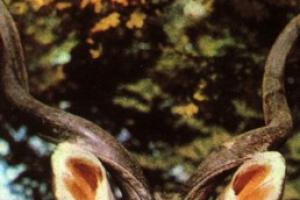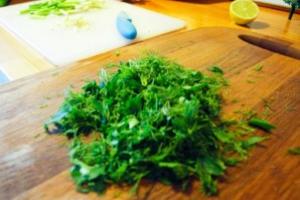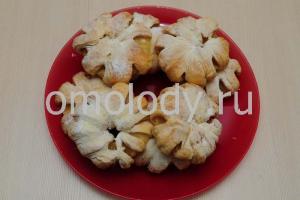For a gardener, autumn is not only the end of summer and harvest, but also the beginning of preparation for the new season. In order for your plants to delight you next summer with healthy foliage and lush flowering, and in the fall with a rich harvest, you need to prepare the plants for a long and harsh winter, carry out all the necessary autumn work in the garden.
In autumn, all nature prepares for hibernation. Sap flow in plants slows down, growth stops, insects, including pests, look for places to overwinter: to do this, they try to hide under fallen leaves, in cracks in the bark; rodents are moving closer to the gardens. Spores of diseases accumulated over the summer remain on unharvested fruits and fallen leaves. The gardener’s task is to reduce the number of these garden enemies and prevent them from overwintering.

To do this, starting in August and in September before the leaves fall, we collect carrion from the ground and dried (mummified) fruits from fruit trees and destroy - burn.
All fallen leaves are raked and removed from the garden. Another option: it can be treated with a 7% urea solution to kill disease spores. In this case, the leaves are not collected, but buried in the ground in the spring.
When planting strawberries, dry leaves and flower stalks are removed and burned.
Fertilizer application and winter watering
IN tree trunk circles Phosphorus and potassium fertilizers are applied during digging.
Nitrogen can no longer be used!
If there was little rain in the fall, water-charging (pre-winter) irrigation is carried out.

Pre-winter watering of the garden
It will help the trees to survive the winter well. Enough moisture will accumulate in the tissues and the trees will not suffer from winter drying. The volume of watering should be large. If possible, simply lay the hose on the ground, for example, overnight.
Spraying against pests and diseases

- With the beginning of the leaf fall period, the crown is sprayed with a 4-5% urea solution to prevent scab and other diseases. The solution is prepared as follows: 400-500 g of urea are dissolved in 10 liters of water.
- After leaf fall, at the end of October, fruit trees and shrubs are sprayed with a 3% solution to prevent the development of mosses and lichens iron sulfate(300g per 10 liters of water).
- To prevent fungal diseases, stone fruit crops (cherries, plums) are sprayed with 2-3% Bordeaux mixture or 0.4% copper oxychloride (1-2 times with an interval of two weeks).
- On black currants, gooseberries, raspberries, we cut out and destroy fruit-bearing and damaged shoots, and also cut out branches affected by powdery mildew.
- To prevent fungal diseases (powdery mildew, leaf spot), treat the bushes with a 1% solution of Bordeaux mixture 2-3 times with an interval of 10-14 days; It is also good to spray currants with 1-5 solutions of colloidal sulfur.
- To reduce the number of overwintered pests, treat the bushes with Karbofos (75 g per 10 liters of water).
Bordeaux mixture, which must be specially prepared before use, can be replaced with drugs such as Hom, Kuprosat, Abiga-Pik
Digging up the soil and adding deoxidizer

They dig up the ground under bushes and trees - this will help destroy the pest larvae that have gone underground for the winter. For this purpose, you can dig up all the soil in the garden to a depth of 20-25 cm.
Along with autumn digging, a deoxidizing agent is added to acidic soils. It could be:
- dolomite flour (approximately 500 g per square meter);
- fluffed lime (500-600 g per sq. m);
- wood ash (600 g per 1 sq.m.).
Liming the soil increases the winter hardiness of plants. Stone fruit crops especially need the addition of lime.
Whitewashing trees and peeling bark

At the end of October - beginning of November, when the trees have entered a phase of relative dormancy, the trunks and skeletal branches of fruit trees are cleaned of dead bark with a special brush.
Convenient tool for cleaning barrels - garden saw. Its teeth easily “scrape off” the most stubborn areas of the bark
Together with the old bark, the trunks are cleared of disease spores and pest larvae. Clean trunks and skeletal branches down to the living green layer without fear of damaging it - scratches on the “living” layer contribute to the thickening of the trunk.

After such cleaning, it would be good to whitewash the trunks with a special paint, which will protect the bark from sunburn and frost damage, and adding a small amount of copper sulfate to the whitewashing will serve as a good prevention of fungal diseases in the next season. Whitewash can be bought in stores. There it comes in several types:
1. Whitewash based on lime and clay without special additives. Advantages: environmentally friendly, has a porous structure - the bark “breathes”. Disadvantages: short-lived, easily washed off by rain.
2. Special paints. Can be acrylic or water-based. Sometimes available in aerosol packaging. Advantages: they contain special protective substances; stays on for a long time without washing off. Disadvantages: dense and do not allow the plant to “breathe” well. Best used on young plants.
3. Self-made whitewash. It is prepared as follows: fluffed lime is diluted with water in a ratio of 200 g per 1 liter (2 kg per 10 liters), several tablespoons of paste and 30 g of copper sulfate are added to the resulting solution.
Trees benefit from whitewashing, which replaces the paste with clay and mullein.
At the same time, you can do sanitary pruning and wound treatment. Lubricate the largest cuts again with garden varnish; this will protect the wood from winter drying out.
Carry out pre-winter moisture-recharging watering, if not done before.
Barrel protection

An important event among the autumn work to prepare the garden for winter is the protection of the trunks of young fruit trees from the invasion of hungry rodents: mice, hares, and sometimes large animals, for example, roe deer. For such protection, it is best to wrap the trunks and skeletal branches with a mesh: plastic or metal.

Currently on sale special tapes for winding trunks. From available means, spruce branches or nylon (old stockings) are often used. The latter remedy has proven itself especially well.
You can use film or roofing felt to wrap trunks only if you have time to quickly remove them when warm weather sets in, otherwise the use of these products will lead to heating and damage to the bark
In anticipation of snowfalls, branches growing at an unfortunate angle are fastened together to avoid breaking.
Preventive spraying, removal of damaged fruits and leaves, cleaning and whitening of bark, pre-winter moisture-recharging watering - these are the activities that will help your garden safely survive the harsh winter.
Correctly carried out autumn work in the garden is the key to a good harvest and lush flowering next year.
Urea is amides of carbonic acid, which are colorless, odorless crystals. Among gardeners and gardeners, urea (urea) is often used as a universal, highly effective granular nitrogen fertilizer.
The use of urea promotes the development and growth of plants and their abundant fruiting. Urea as a fertilizer has proven itself excellent among amateur gardeners.
1 How to use urea?
When using urea as a fertilizer in gardening or vegetable gardens, you need to take into account that in a few days it is modified and transformed under the influence of bacteria that are in the soil.
The best results are obtained by applying urea not only to gardening farms, but also to greenhouses. To achieve maximum beneficial effect It is necessary to quickly incorporate urea into the soil in order to reduce the loss of ammonium carbonate to a minimum. This action significantly increases the level of nutrients, namely nitrogen, entering the plants.
Urea can be used on any soil as a fertilizer or feed for garden and fruit plants. Although this product has versatility, it is still worth remembering that different crops need different amounts of fertilizer. Therefore, the nutritional supplement must be applied in certain doses depending on the plants.
Treatment of gardens and vegetable gardens with urea as a fertilizer during the growing season is used:
- for processing cabbage, peppers, onions, beets, tomatoes, potatoes and garlic 19–23 g/m²;
- for feeding peas or cucumbers, add about 6–9 g/m²;
- for zucchini, eggplant and squash 10–12 g/m²;
- for grains 300 grams per hundred square meters in granular form;
- for protection against pests and diseases in the garden, foliar feeding vegetable crops 9–15 g for every 10 liters. water;
- for garden strawberries and wild strawberries. Fertilizer is applied to the soil before planting berries. Before the appearance of ovaries and buds, spraying with urea 10 g is used. for 2 liters of water. To increase the yield, fertilize with a concentrated solution of 60 g. for 20 liters of water at the beginning of September or at the end of August.
1.1 Application features, properties and consumption of urea as a fertilizer (video)
2 Fertilize the plants
To get a full harvest of cucumbers, you need to feed them. Without fertilizing, plants are prone to poor fruiting and early leaf loss.
Cucumbers can be fed from the beginning of seed germination until the period of fruiting. Plants are saturated with organic substances and beneficial elements. Urea is applied as a top dressing for cucumbers in a volume of 7-8 grams per meter of plot.
Fertilizer must be applied twice during the entire growing season. To increase productivity, cucumbers are fed with a concentrated mixture: 60 grams of urea per 20 liters of water.
2.1 How to dilute urea for garden treatment?
With the use of granules everything is clear, you just need to measure required weight, and then apply fertilizer to the soil. That's why special attention requires dilution of urea because many, especially beginning farmers, are interested in the question of how to properly make a solution of the required concentration from it.
2.2 Spraying the garden against pests in spring
Spraying the garden in the spring can be done using copper sulfate; it is recommended to start processing in March, when the air temperature is plus 5 and above.
Every summer resident wants a cozy and beautiful garden all year round, for this the trees need to be healthy. It is necessary to spray against pests and their larvae in early spring fruit trees. To begin with, the trees are pruned, inspected, and removed from old bark and lichens.
It is necessary to spray before the buds begin to awaken, because the purpose of this event is to destroy pests that are in the wintering stage: copperhead, aphid eggs, apple blossom beetle, weevil. Early spring spraying of the garden using the double action method allows you to achieve maximum effect.
For this, the following proportion is used: carbamide (urea) with 3 percent copper sulfate in the proportion of 10 liters of water, stir 700 grams of urea and 50-100 grams of copper sulfate. This solution will get rid of overwintered garden pests and provide sufficient nutrition for bushes and trees in the form of nitrogen fertilizer. Sprayed trees will have a great start in spring.
2.3 Autumn treatment of the garden with copper sulfate and urea
Every garden, even the most well-groomed one, is not immune from diseases and pests. This is especially true for apple trees affected by scab. Insects and wind carry disease-causing spores, and damp weather promotes infection.
Scab damages leaves and shoots and spoils the harvest.
Destroying pathogenic spores in the fall will help prevent scab next season.
The tree is sprayed with a solution, which has the original name - Bordeaux mixture. It is used by gardeners to combat a large number of infections. You need to spray apple trees with a solution prepared from 400 grams of copper sulfate and 300 grams of lime diluted in 20 liters of water. Autumn treatment of apple trees will save trees and crops from diseases and pests.
Also in the fall, currants and grapes are treated with urea. Currants are treated with urea in the fall to kill pests and prevent rotting of the root system. With the onset of cold weather, humidity increases, which is the optimal environment for the emergence of diseases and widespread infections. To do this, autumn treatment of the garden with urea is carried out in the form of spraying.
Processing grapes in autumn is effective method pest control. Spraying with urea will rid the grapes of leaf roller and phylloxera. Any fungicide can be added to the solution to increase the effect.
Treating the garden with urea will help gardeners protect their plants and fruit trees from pests, and the roots from rotting. For achievement best results it is necessary to use the drug in the correct proportions and for a certain period of time. The processed harvest will be abundant and rich. Carbonite is a universal fertilizer that will help garden and vegetable plants grow.
The apple trees in our garden bear fruit one year and rest the next. Last year there were practically no apples, so we expect a rich harvest next summer. It cannot be said that the fruit trees on our site are very sick or affected by pests. But every spring we try to carry out preventive spraying. It happens that we forget or miss time, then the apples are slightly affected by scab. Conclusion: there is definitely a benefit to spring spraying the garden. Question: what is the best way to spray apple trees in spring??
Traditionally for spring garden spraying use Bordeaux mixture. This topic was discussed in detail in the article. Treatment is carried out in early spring before buds open. They also use the now fashionable Fitosporin (we have not tried it yet, but we are planning to). And my grandmother read in one of the country magazines that spray fruit trees in spring useful with a strong solution urea (urea). But the dosage should be generous: 700-800 g per 10-liter bucket of water.
My husband and I looked at each other and decided to check it out. Why did such figures raise doubts? Yes, because for foliar feeding of apple trees, a dose of 30-50 g of urea per 10 liters of water is given. And to prevent diseases, it turns out that the dose should be 20 times higher!!! Upon arriving home from the dacha, I sat down to study reference books and this is what I managed to find out.
Urea solution for spraying trees: application
All sources give two doses for spring spraying:
- 30-50 g of urea per 10 liters of water (for foliar feeding),
- 500-800 g of urea per 10 liters of water (for the prevention of diseases and against pests).
But indeed, to treat trees in early spring BEFORE the buds swell (and this is the end of March - April), a solution of increased concentration is used. More often take 700 g of urea and dissolve in 10 liters of water. Can be added to the solution 50 g copper sulfate- it will increase its effectiveness.
So, when to spray:
- At the end of March - April, along bare branches and sleeping buds.
If you are a beginner gardener, please note:
- Urea may be sold in garden centers under the name "urea". Both options are actively used in speech.
Let's look at it in more detail
Vladislav Fatyanov in the book “Your Garden” talks about spraying trees in the spring with a 0.5% urea solution after flowering (for feeding) and 5% late autumn(against scab). How to prepare a urea solution for spraying trees in the fall? The solution should be 5%, that is, take 500 g of urea per 10 liters of water.
B. D. Zhdanovich and L. I. Zhdanovich in Reference manual in gardening They recommend foliar feeding in spring with a urea solution (2-3 matchbox per 10 liters of water). This source recommends spraying with HIGH doses of fertilizers in September-October, as a top dressing and to combat pests and diseases. In this case, a 6-8% solution is prepared: 600 - 800 g of urea per 10 liters of water. The manual states that the tree trunk circles need to be sprayed.
Let's move on. M. Zhmakin in the book “Preparing the site for spring” in the section “Helping plants after wintering,” he writes that urea is effective against pathogens of fruit tree scab that overwinter in fallen leaves. In spring, apple and pear trees are sprayed with a 7% urea solution (700 g per 10 liters of water) . Solution consumption: 25 liters per 100 square meters. The author clarifies that the solution should not get on the bark of trees - this can cause a burn.
But before listing the preparations for chemical spraying (including urea), the author writes about abundantly wetting the branches and trunk with chemical solutions. In my opinion, there is some contradiction:
Important: The Encyclopedia says that Spraying in the spring should be carried out on dormant buds, before they bloom . The tree itself (crown, trunk) and the soil in the circle around the trunk are sprayed.
How to dilute urea for spraying?
So, after analyzing these sources, we can conclude:
- Urea should be diluted for spraying fruit trees in the spring (before buds open) or in the fall (after harvest) in a proportion of 500-800 g per 10 liters of water. Most authors talk about a dose of 700 g per 10 liters for spring spraying. This treatment is carried out for the purpose of disease prevention.
- And as a foliar feeding, use the dose: 30 - 50 g per 10 liters of water:
An alternative to urea is solutions of copper sulfate or Bordeaux mixture:
How to prepare a urea solution for spraying trees?
We conducted our own experiment and prepared a solution of urea (carbamide) for spraying trees in the spring, according to the above recommendations.
- Pour 500 or 700 g of urea (not a whole pack) into a 10-liter bucket.
2. Filled with water.
3. Strained the solution, because even tiny particles ways to clog the sprayer.
How to spray trees with urea in spring?
Spraying is very convenient to carry out using the Zhuk garden sprayer. Our gardener neglected the safety rules, and should have covered his face and hands. The solution is very concentrated, and therefore contact with the skin and mucous membranes can cause a chemical burn. It is recommended to spray trees on cloudy days, not rainy weather, in the morning or evening.
Have you tried spraying trees with urea? Share your experience in the comments 😉 we will be glad!
Preface
Who among us would want to eat fruits in our diet if we learned that the trees on which they grew were treated with a large amount of chemicals? That's right, no one. What to do to get a healthy harvest and what preparations are needed for cultivating the garden - read our article!
Required tools and materials
Bucket
Preparations for garden treatment - help yourself
For most citizens, the issue of using drugs used to treat the garden is quite important, because no one wants the chemicals to remain in the fruits and then enter the body. And everyone understands that poisoning yourself harmful substances dangerous. Meanwhile, experts in the agrochemical industry assure that these drugs are the most effective in the fight against diseases and all kinds of midges. The calendar they offer for treating gardens against pests has a fairly packed schedule. Thus, spraying is carried out in four stages: the first - before flowering, the second after, the third only 10 days after the second spraying and the fourth - 10-12 days after the previous one.
But, having our own garden, we can easily control the doses of the drug used on our site. After all, each of us can stop in time and not use this or that substance unnecessarily, using reasonable doses in the fight against, for example, apple trees.So, there are several drugs most often used in garden treatment - urea (urea) and copper sulfate. Everyone has heard of at least one of them, even if they have nothing to do with gardening. The main advice from experts is as follows: if you have a healthy garden, then you should not treat it with so many drugs. There is no need to spray even if the concentration of pests on the trees is too low. This is acceptable. Problem areas can be treated selectively. It is also important to carry out, if you have already decided to do so, the treatment of trees on time and, most importantly, to properly dissolve the preparations before using them. If you still decide to spray, then find out which drugs affect which processes. The same policy should be followed at the market, where when buying fruits from hand, you can ask the owner of the garden about the class of chemistry he uses when growing them. Another thing is that no one guarantees you the truthfulness of the answer.
In our case, the number of treatments matters. After all, many have probably noticed that apples in supermarkets can be on the shelves for several weeks and not spoil at all. Most likely, in this case, these products were processed more than once to achieve this result. So, if you bought a seemingly tasty and juicy fruit outside of the ripening season, this is not yet a reason to rejoice at the vitamins your body has received. Although, of course, quality control exists in the system of food procurement and sales, it is better to insure yourself and not take risks with such purchases.
Treating the garden with copper sulfate - what, why and why
Every summer resident wants to receive good harvest, but sometimes without using the same copper sulfate, you simply cannot get what you want. Pests that multiply at a rapid pace, along with plant diseases and not always favorable weather, generally lead to the fact that both bushes and trees in the area begin to die. Experts advise that if you experience a similar situation every year, use it against pests and diseases. chemicals– fungicides. They help prevent the most common bacterial and fungal diseases, and besides this, cure already diseased plants.
Thus, a solution of copper sulfate, the strength of which is 2%, is best used in early and late spring when spraying. Helps against fruit rot and a number of other diseases. When preparing the solution, it is necessary to take into account that it is mixed only in wooden or, possibly, in enamel containers. First, vitriol crystals are poured hot water so that they dissolve better, and then add a little more cold water. If you use copper sulfate in its pure form, you will simply burn your plants, so this solution can only be used in a mixture in a 1:2 ratio with slaked lime or soda.
The “Bordeaux liquid,” familiar to many, is a mixture of copper sulfate and milk of lime. This solution is successfully used against many fungal diseases, although it does not help to cure powdery mildew. You can prepare the liquid yourself - for this, use wooden dishes pour a little hot water and dissolve 1 kg of copper sulfate in it. Next you should add 50 liters cold water. In another container, 1 kg of lime is slaked. Then add 50 liters of water and filter. Before spraying, it is necessary to slowly pour the vitriol solution into the milk of lime. And then you can use it on plants.
Experts advise carefully carrying out such processes and mixing the compositions only in the specified sequence.
In addition, in no case should Bordeaux mixture be diluted with water after its preparation. And yet, you need to use the solution only in warm and dry weather, since in extreme heat, burns may remain on the leaves and fruits, and rain will simply negate all your efforts.
Treating the garden with urea increases yield and fights pests
Urea also copes with the invasion of insect pests on trees. Urea can be used both as a fertilizer and as a means of combating various pests. So carbamide (urea) is used for treatment after the arrival of heat, if the average daily temperature is plus 5 degrees or higher, until the buds begin to grow. In this case, pest control is carried out at the wintering stage. Trees are sprayed with a concentrated solution of urea, 500–700 grams per 10 liters of water. This treatment should be carried out if there was a pest invasion last season.
This solution also helps with diseases such as purple spotting or scab. Spraying the garden with urea can also be done in the fall. Tree leaves are sprayed, which helps reduce the ability of subsequent infection of the apple tree. Ammonium nitrate or potassium chloride can replace urea (carbamide). They only treat the soil with it, but not the bark and buds.
In addition, urea has long become widespread not only in large farms, but also in summer cottages as an effective nitrogen fertilizer. It accelerates the growth of the plant. In addition, they like to use it for its ease of use, rapid solubility and extraordinary ease of absorption by plants. This is the most concentrated nitrogen fertilizer that can be used both for personal plots, and in large farms. Easily soluble in water, it is suitable for all types of soils as fertilizer and top dressing. Does not harm leaves and does not leave burns on plants. Let us remind you that the selection of dosage should always take into account the characteristics of the fertile layer and soil typeTips for treating the garden with preparations:

Spring spraying of the garden with urea and other possible substances (for example, iron and copper sulfate) is the key to a rich harvest. garden trees. With the onset of spring, the temperature increases in algebraic progression. While the probability of plant disease is geometric. For example, it could be a monilial burn or purpuric spot. To protect your own garden, experienced gardener turns to urea.
This product can prevent the proliferation of pathogenic bacteria that cause these diseases. It will realize effective fight s and their larvae that survived the cold winter in the bark of trees. For example, treating apple, plum and pear trees with urea during their flowering period will solve the problem of the appearance of leaf roller caterpillars, aphids and apple blossom beetle.
Urea, which is also called urea, in addition to everything else, promotes the rapid growth and development of plants, as a result of which it can be used on any soil and for any fruit trees.
Period of garden treatment with urea
It is much easier to treat fruit trees in early spring than after flowering. In May days, pollinated urea will not be able to reach the upper branches of plants due to dense young foliage and will not destroy foci of infection on the tops of trees. The result will not be visible. If the garden, in general, consists of trees that allow urea to penetrate through young foliage (for example, pears and plums), then late spring or even summer treatments will also be very effective.
Early spring spraying of the garden with urea is also aimed at combating severe spring frosts. The nitrogen contained in urea will slow down the tree's metabolic processes for a couple of weeks and will not allow young foliage and delicate inflorescences to bloom prematurely. Thus, frosts, which can cause irreparable damage to fruit trees, will pass by. This property is especially useful for gardens consisting of early ripening varieties trees such as peach, plum or apricot.
Practical tips and recommendations for spraying the garden with urea in spring
Urea is granules of organic nitrogen-containing fertilizer, white in color, odorless, easily soluble in water. Unlike other nitrogen fertilizers, it is safe for plants even in large doses (accidental overdose).
Points not to forget:
During the flowering period of fruit trees and after the ovary, the second and third treatments with urea are carried out, respectively.
VIDEO: how to properly spray the garden with urea in the spring?
Then we invite you to watch a video on the topic of spraying your own garden with urea in the spring:



























